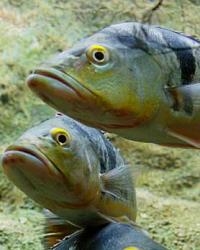Magical journey through the world’s rivers
Submitted on 16 July 2006 - 12:21am
This article is reproduced by CienciaPR with permission from the original source.

By Gloribel Delgado Esquilín / Special El Nuevo Día
endi.com
Being able to recreate the conditions of tens of rivers in five continents of the world has been a big task that has taken marine biologist Victor Ortiz more than 25 years of study and passion, to be able to make “Rivers of the World, The Aquarium” possible, that will open its doors to the local public Friday morning.
The scientist, with an academic formation from the University of Puerto Rico Mayagüez and experience in the construction of aquariums in China and Australia, knows like the back of his hand each centimeter of the 34 thousand square feet that occupy good part of the second floor of the Tower of Prayer, of the Church Fuente de Agua Viva in Carolina, where the aquarium is.
Species as rare as Arapaima giga, a prehistoric animal that could measure 13-20 feet, cohabit there with albino African frogs, an hermaphrodite Australian fish that is born male and dies female, shrimps from Thailand, thousands of Amazonian neon fish, the Puerto Rican buruquena, common man rays and an eel from the Orinoco able to generate a current of more than 600 volts.
“In this aquarium the visitor will learn about the birth of a river, the creation of the spring and its development until arriving to the delta and mixing up with the sea water”, explained the scientist while he shows one of the fish tank that recreates these conditions, with several species of globe fish and monodactylus argenteus brought directly from Argentina.
The biologist walks among the 38 tanks of the place, divided by regions and ecosystems, and is able to narrate any detail of the selective sample of fish from the Orinoco, Australia, the Amazon, native, introduced exotic species to Puerto Rico in last decades, invertebrate fish, species of the United States lakes and two important African lakes, the Malawi and the Tangayika.
“Rivers are drying because of the amount of factories and urbanism that is infecting them with tubes and architectonic barriers. Every time they become more limited and the species that live in them are in danger more than those than live in the sea”, explained the biologist.
Between the most important species of the aquarium are two protected species: the extraordinary Arapaima giga, a prehistoric animal of more than 60 million years that originally evolved in the rivers of the Amazon, and the sturgeon, one of the biggest fish of the world.
“This type of fish is collected in rivers and given to public aquariums so people get to know them, because they are endangered. In the case of the Arapaima giga is a species that is disappearing, because it is edible and its meat is very well quoted in the black market”, commented this boricua.
One of the primary goals of the aquarium, according to what he said, is to foment the scientific study of the aquatic life and to know the biodiversity and the dangers that native species face.
As part of the exhibition, the aquarium counts on four endemic species of Puerto Rican fish difficult to see in the local rivers. Dajao, the Puerto Rican eel, the guavina and mapiro are species of Puerto Rico that are born in salt water and live in fresh waters.
“These species live the other way around that the salmon, that goes from river to sea”, comments the biologist while observes how several gold fish devour what he just fed them for lunch.
“For the next summer we will be designing a summer camp curriculum to show students to conserve the life in beaches, to foment sowing of seaweed, the importance of saving the estuaries of Puerto Rico”, emphasizes when assuring that also for the next year the second phase of construction of the aquarium in first floor of the building could begin, and that will include fish and ecosystems of salt water.







